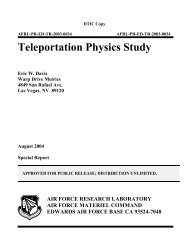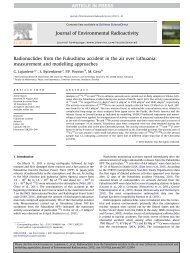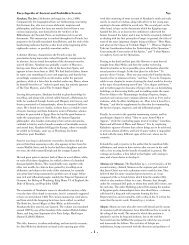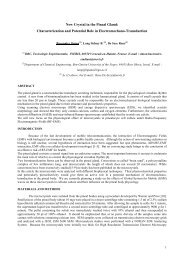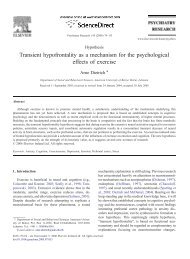focuses on the depressive characteristic in the terrorist personality. According to Konrad Kellen, thisexplanation reveals a terrorist who “<strong>of</strong>ten is a person who feels empty, anhedonic and …as a child hemay have suffered from the triad <strong>of</strong> enuresis fire setting cruelty to animals” (Kellen, 1979, p.2).-With regards to Cooper’s assertion that the death wish is part <strong>of</strong> the sociopathic personalities <strong>of</strong>political terrorists, other observers disagree.-The hypothesis that terrorists are motivated by a death-wish thus remain unsubstantiated.-The mental disorder perspective <strong>of</strong> political terrorism clearly suffers from the absence <strong>of</strong> clinicalobservations reported in a manner that compares or allows them to be compared to a generalpopulation sample. Additionally, there is little <strong>of</strong> the cross-cultural and cross-national datanecessary to examine the relative importance <strong>of</strong> culture and personality.-Physiological Impairments and Mental Disorders:-E. Patrick McGuire reported that Hubbard andanother psychiatrist, F. Gentry Harris, examined 80 imprisoned terrorist in 11 countries and foundthat 90% <strong>of</strong> them had defective vestibular functions in the middle ear.-What he suggest, rather is that certain personas who engage in terrorism for strictly personal ornonpolitical reason suffer from personality disorder characteristics. These persons are identified byHubbard as soloists. They act alone and appear virtually incapable <strong>of</strong> undertaking the groupbehavior required by political terrorists.-Hubbard identifies two other types <strong>of</strong> terrorist types, the conspirator and the groupist . These twotypes appear more likely to engage in political terrorism. The conspirator also is exhibitionistic, butis motivated primarily by the fear <strong>of</strong> unresolved grief. The groupist in contrast, usually avoidspublic identification and willing surrenders his individual ego needs to the interests <strong>of</strong> the group.-What remains confusing in Hubbard’s work is the physiological factors that he hints are related toterrorists: “I suspect it will be possible to determine specific chemical distinctions among andbetween soloist, conspirators and Groupists during moments <strong>of</strong> their actions” (Hubbard, 1978,P.191).-As long a Hubbard is unwilling to provide detailed descriptions <strong>of</strong> his data and analysis procedures,the assertion that inner ear impairments tend to produce renegade or antisocial behavior such asterrorism appears to be conjecture.-Rational-Idealist Perspective: -No theorist from this perspective views every political terrorist as arational idealist.-Irving Goldaber (1979) divides them into idealistic protestors, ideological zealots, and terroristextremists.-Paul Wilkinson is a leading proponent <strong>of</strong> the rational idealist perspective who nevertheless believesthat many Western terrorist are criminals or criminally insane.-J. Bowyer-Bell’s view <strong>of</strong> political terrorism is more typical <strong>of</strong> the rational idealist perspective, sincehe rejects the importance <strong>of</strong> both pathology and liberal democratic interpretations <strong>of</strong> revolutionarypolitical terrorist such as the Japanese Red Army.-Pr<strong>of</strong>essor Wilfried Rasch <strong>of</strong> the Institute <strong>of</strong> Forensic Psychiatry <strong>of</strong> the Free University <strong>of</strong> Berlinexamined leaders <strong>of</strong> the Baader-Meinh<strong>of</strong> Group another West German terrorist and concluded thatwith one exception “nothing was found which could justify their classification as psychotics,neurotics, fanatics or psychopaths. None <strong>of</strong> the men and women I saw could have been diagnosed as“paranoid.” This applies particularly to the four main defendants who died in the Stuttgart prison:Baader, Meinh<strong>of</strong>, Ensslin, and Raspr” (Rasch, 1979, p.80)50. Cota-McKinley, A., Woody, W., & Bell P. (2001). Vengeance: Effects <strong>of</strong> gender age religious background.Aggressive Behavior, 27, 343-350.Call Number: Editor's Annotation: Authors Abstract: Vengeance can be commonly defined as theinfliction <strong>of</strong> harm in return for perceived injury or insult or as simply getting back at another person.Three hundred fifty-three participants responded to eight hypothetical scenarios that may elicitvengeful behavior in which the <strong>of</strong>fending party was either a romantic partner, a friend, a coworker,or a stranger. Participants also completed a vengeance scale and a measure <strong>of</strong> biblical literalism.Participants were most vengeful toward coworkers and least vengeful toward romantic partners.Age, religious conservatism, and gender were significant predictors <strong>of</strong> attitudes toward vengeance.Although men were more likely than women to be accepting <strong>of</strong> vengeful attitudes as measured bythe vengeance scale, only age was a significant predictor <strong>of</strong> behavior in the vengeance scenarios.The current research provides a basis for a systematic investigation <strong>of</strong> vengeance within the structure
<strong>of</strong> human relationships and interactions. Aggr. Behav. 27:343350, 2001.-Vengeance can be commonly defined as the infliction <strong>of</strong> harm in return for perceived injury orinsult or as simply getting back at another person.-Revenge fulfills a wide variety <strong>of</strong> goals, including righting perceived injustice, restoring the selfworth<strong>of</strong> the vengeful individual, and deterring future injustice. Central to the concept <strong>of</strong> revenge areperceptions <strong>of</strong> personal harm, unfairness, and injustice and the “anger, indignation, and hatred”associated with the perceived injustice [Kim and Smith, 1993, p. 38; see also Stuckless andGoranson, 1992]. The perceived injustice must be righted or undone, and revenge, despite socialtaboo, is <strong>of</strong>ten seen as an acceptable means <strong>of</strong> doing so.-Ellison [1991] found two religious variables that influenced acceptance <strong>of</strong> defensive violence todefend the honor and safety <strong>of</strong> one’s self and one’s family. He found that hierarchical images <strong>of</strong> Godas a master and judge were associated with increased acceptance <strong>of</strong> defensive violence. “Much <strong>of</strong>hierarchical theology stresses the themes <strong>of</strong> moral judgment and divine punishment prominent in theOld Testament” [Ellison, 1991, p. 1233]. These views are highly correlated with the literalacceptance <strong>of</strong> the Old and New Testaments including all <strong>of</strong> the views on revenge describedpreviously.-Participants in the current study were asked to evaluate several hypothetical situations that may ormay not elicit vengeful behaviors and to rate how vengeful they would be in those situations.-Three hundred fifty-three introductory psychology students, 118 males and 235 females, fromColorado State University participated to fulfill a class research requirement.-Participants also completed the Vengeance Scale [Stuckless and Goranson, 1992], for which theyused a 7-point Likert scale ranging from 1 (strongly agree) to 7 (strongly disagree) to address 20statements regarding their attitudes toward vengeance participants completed a religiousconservatism scale [Bensko et al., 1995].-The relationship between the <strong>of</strong>fending individual and the participant was a significant predictor <strong>of</strong>willingness to seek revenge. Participants’ willingness to seek vengeance was highest for coworkers,followed by strangers, friends, and romantic partners, respectively. An analysis <strong>of</strong> aspects <strong>of</strong> thevarious relationships sheds light on the intensity <strong>of</strong> attitudes toward acceptance <strong>of</strong> vengeance.-Gender did not have a main effect on willingness to seek revenge in specific situations, and therewas no significant gender by relationship interaction, although a gender main effect was found inparticipants’ attitudes as measured by the Vengeance Scale. Specifically, it was found that men aremore accepting <strong>of</strong> vengeful attitudes.-And age was a significant predictor <strong>of</strong> Vengeance Scale scores.-Biblical literalism was a significant predictor <strong>of</strong> attitudes toward vengeance; biblical literalists weremore accepting <strong>of</strong> revenge as a motivation for human behavior.51. Crawford, C. (2003). Inside the UDA: Volunteers and violence. London: Pluto Press.Call Number: Editor's Annotation: “In my extensive pr<strong>of</strong>essional experience the terrorist is notsomeone driven by political ideology or other ‘noble’ motivation, but much more usually anordinary person, driven beyond his or her point <strong>of</strong> tolerance by extraordinary circumstance.” Thisquote from the introduction lays the groundwork for the author’s approach to understanding theterrorist mindset. While most books on the Ireland “troubles” focus on the IRA and other separatistfactions, this one deals with the perspective <strong>of</strong> the “loyalists” (those not wanting Northern Ireland toseparate from British control).-The Ulster Defense Association (UDA) was developed as an organizational umbrella to coordinatethe activities <strong>of</strong> numerous Protestant Defense Associations. It evolved into a rather largeparamilitary organization (50,000 member sat its peak), with hierarchical structure but problemsaccessing weapons and training. Chapter Three provides a useful history <strong>of</strong> its transformation into aparamilitary force. In the chapters that follow, he provides descriptions from each <strong>of</strong> the UDA’s fourphases <strong>of</strong> operational existence and also <strong>of</strong> the Greysteel massacre. The stories are conveyedthrough detailed first-person biographical accounts, many done with incarcerated operatives. Thebook does not provide general, overarching principles to frame the understanding <strong>of</strong> terroristbehavior, but the individual accounts are rich with “data” from personal experiences.52. Crayton, J. W. (1983). <strong>Terrorism</strong> and <strong>Psychology</strong> <strong>of</strong> the Self. L. Z. Freedman, & Y. Alexander (Eds),Perspectives on <strong>Terrorism</strong> (pp. 33-41). Wilmington, Delaware: Scholarly Resources.
- Page 2 and 3: MethodologyWe have defined terroris
- Page 4 and 5: Reference List1. Root causes of ter
- Page 6 and 7: - The experience of discrimination
- Page 8 and 9: justification across all three reli
- Page 10 and 11: 11. Bandura, A. (2003). The origins
- Page 12 and 13: ather then from their own volition.
- Page 14 and 15: -If the women's liberation movement
- Page 16 and 17: technology and science.-Although mo
- Page 18 and 19: effects that help facilitate violen
- Page 20 and 21: academic fields of study.-Terrorism
- Page 22 and 23: one’s own group and towards other
- Page 24 and 25: marked cars, do not mount stationar
- Page 26 and 27: ethnic group: he or she must also s
- Page 28 and 29: third option involves becoming 'thr
- Page 30 and 31: discriminative stimuli that are tem
- Page 32 and 33: him to disengage from the organizat
- Page 34 and 35: or split into terrorist organizatio
- Page 36 and 37: -Part of the complexity of terroris
- Page 40 and 41: Call Number: Editor's Annotation: W
- Page 42 and 43: unanimity has only infrequently ser
- Page 44 and 45: sensitivity to betrayal, and securi
- Page 46 and 47: -People may not support a resistanc
- Page 48 and 49: splinter off from the main organiza
- Page 50 and 51: seduced by the lures of omnipotence
- Page 52 and 53: Most past research findings are bas
- Page 54 and 55: terrorist groups break away from la
- Page 56 and 57: -A second general theory of organiz
- Page 58 and 59: -Violence was justified, first of a
- Page 60 and 61: -Conclusion: When disruptive social
- Page 62 and 63: Call Number: Editor's Annotation: C
- Page 64 and 65: terrorist groups even between group
- Page 66 and 67: grievances and his concomitant will
- Page 68 and 69: -Yet forecasting requires theory, t
- Page 70 and 71: highly organized or institutionaliz
- Page 72 and 73: -Underprivileged groups are likely
- Page 74 and 75: situations where the terrorist moti
- Page 76 and 77: 1977), including in the Palestinian
- Page 78 and 79: -Nor can a general theory of civil
- Page 80 and 81: extent to which deprived occupy org
- Page 82 and 83: -The necessary dependence on new-se
- Page 84 and 85: it relates specifically to the regi
- Page 86 and 87: or class of phenomena, within a giv
- Page 88 and 89:
progress in the analysis of terrori
- Page 90 and 91:
-Loyalty in the face of continuing
- Page 92 and 93:
Republican electorate and also with
- Page 94 and 95:
ecent 1994-96 cease-fire.- certain
- Page 96 and 97:
e reported in news media. Even if a
- Page 98:
eaccompanied back to Italy where he
- Page 101 and 102:
(non believers) facilitates violenc
- Page 103 and 104:
disagreements and disharmony. There
- Page 105 and 106:
autonomy, colonial liberation, raci
- Page 107 and 108:
introduced as the seminal, grass ro
- Page 109 and 110:
identity over personal and familiar
- Page 111 and 112:
-Finally, a comprehensive policy to
- Page 113 and 114:
-It would be naive to think of suic
- Page 115 and 116:
negotiator for the specific situati
- Page 117 and 118:
efused to fight in the Lebanese war
- Page 119 and 120:
-It has been our impression from fr
- Page 121 and 122:
-Many efforts have been made to cat
- Page 123 and 124:
drives that are brought about by (a
- Page 125 and 126:
word.-Consider now the value of ter
- Page 127 and 128:
-The interaction of deprivation and
- Page 129 and 130:
maximize its expected political ret
- Page 131 and 132:
insights into the underlying dynami
- Page 133 and 134:
lengths to secure materials and tec
- Page 135 and 136:
influencing the success of amnesty
- Page 137 and 138:
-The great diversity of terrorism a
- Page 139 and 140:
205. Monroe, K. R., & Kreidie, L. H
- Page 141 and 142:
Call Number: Published Abstract: Di
- Page 143 and 144:
physiological and psychiatric appro
- Page 145 and 146:
2001, suicide attacks amount to 3%
- Page 147 and 148:
numbersas an offering to the bloodt
- Page 149 and 150:
etween radical family involvement a
- Page 151 and 152:
there is no ambivalence concerning
- Page 153 and 154:
dynamics the ‘anarchic-ideologues
- Page 155 and 156:
especially with the parents (33 per
- Page 157 and 158:
esult.-The world is divided into tw
- Page 159 and 160:
pressure from supporters, internal
- Page 161 and 162:
- 1.00 Historical, Cultural, and Co
- Page 163 and 164:
personal rivalry- An extremist fact
- Page 165 and 166:
national governments. At this preli
- Page 167 and 168:
-Normative Orientations directs peo
- Page 169 and 170:
Sicarii views. Insurrection was onl
- Page 171 and 172:
-To have a space of one’s own is
- Page 173 and 174:
outside the normal range of violenc
- Page 175 and 176:
-Various governments sought to curb
- Page 177 and 178:
e older (i.e., 40's-50's)-Sex: Pred
- Page 179 and 180:
liberation Tigers of Tamil Ealam (L
- Page 181 and 182:
electronic communication and inform
- Page 183 and 184:
any other topic on which so much ha
- Page 185 and 186:
has exposed some particular cause b
- Page 187 and 188:
and alone. Ultimately, terrorism re
- Page 189 and 190:
-Conclusions: The motives for param
- Page 191 and 192:
272. Sprinzak, E. (2001). Rational
- Page 193 and 194:
-One way for individuals to handle
- Page 195 and 196:
-Theories of Hate: Fromm (1973/1992
- Page 197 and 198:
student tells the convict his misde
- Page 199 and 200:
literate in EnglishPoor verbal skil
- Page 201 and 202:
features: focusing; personalized vi
- Page 203 and 204:
-Even if idiosyncratic, the process
- Page 205 and 206:
some other agencies’ inaction. We
- Page 207 and 208:
-The RWA is probably the instrument
- Page 209 and 210:
students choose Communist student o
- Page 211 and 212:
state-oriented tradition: by taking
- Page 213 and 214:
phase of semi legality.-Helpers and
- Page 215 and 216:
the neo-Fascists were over 40 years
- Page 217 and 218:
commonality can be found in the utt
- Page 219 and 220:
geographical, and we consider it in
- Page 221:
-The violence struggle against the



